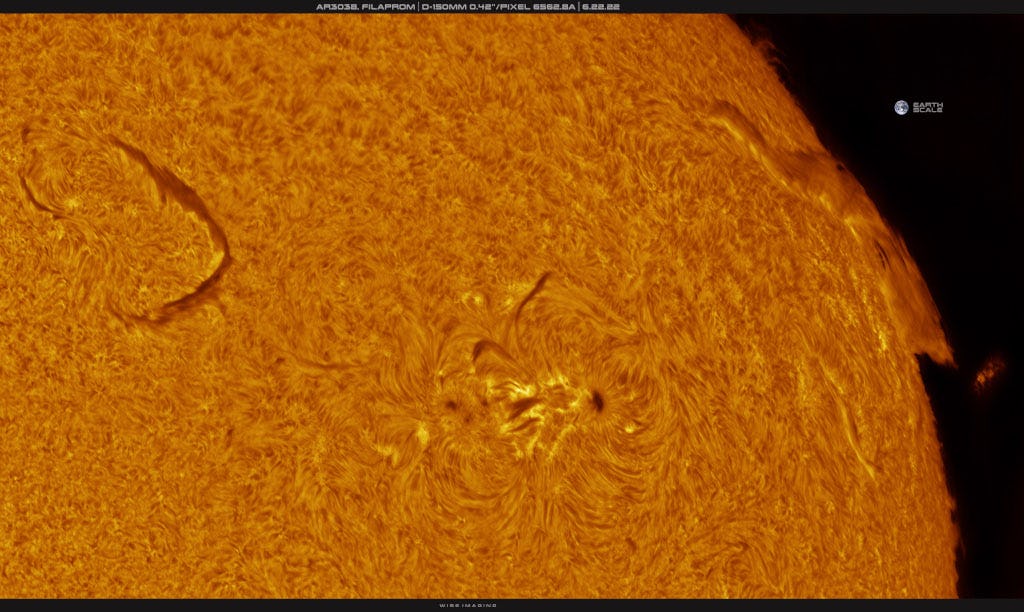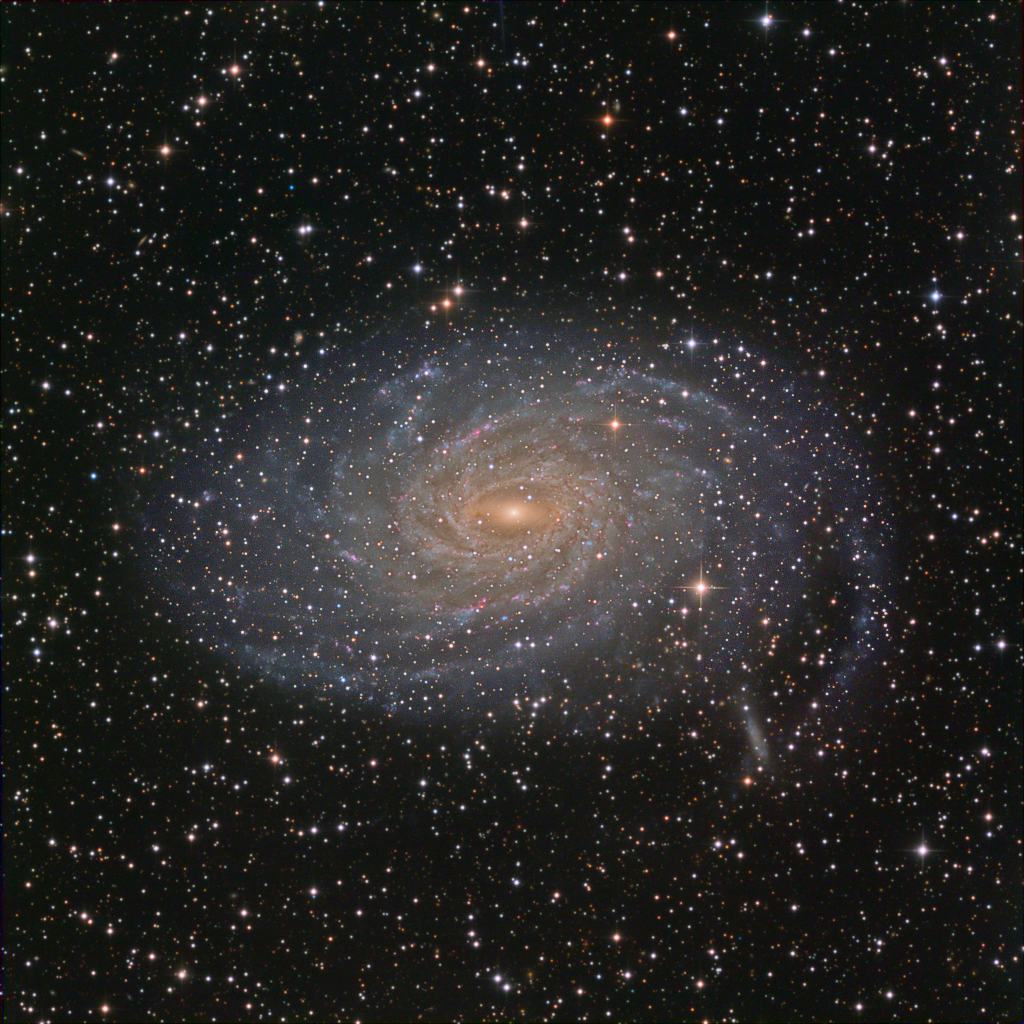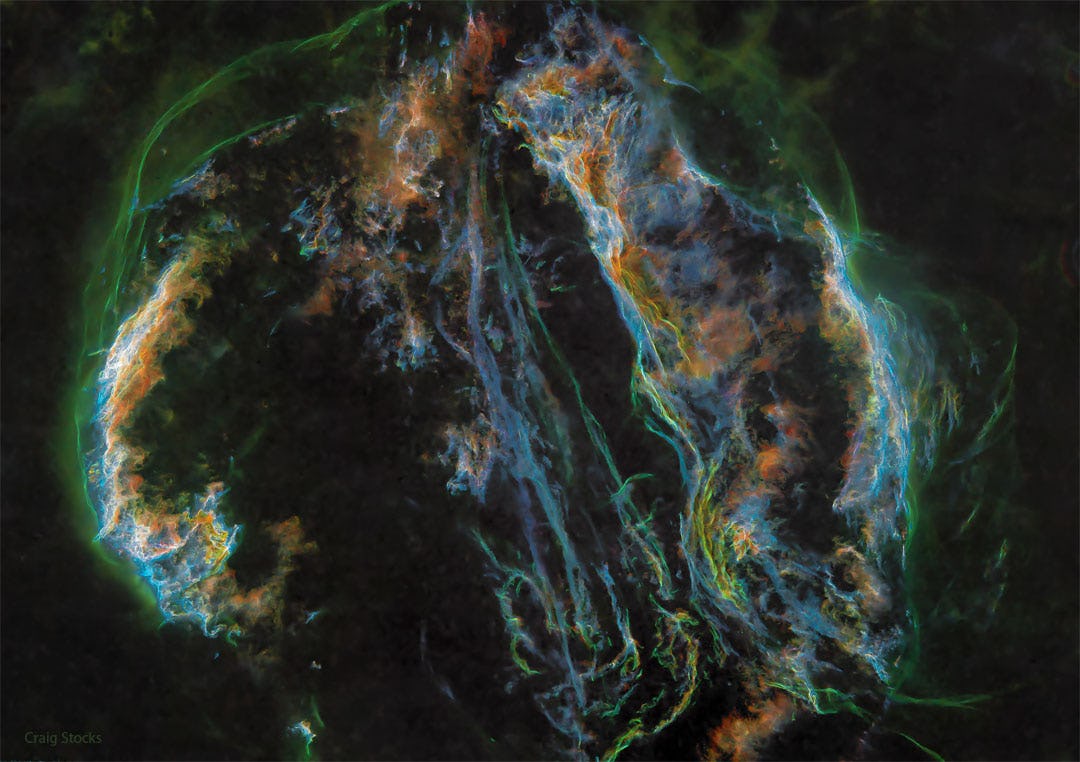Waters rippling
from windy gusts.
Enough wind
to move branches,
not enough
to turn dirt to dust.
Public Posts Stanwood, WA Stanwood, WA (zoom)
NASA Astronomy Picture of the Day:
A solar filament is an enormous stream of incandescent plasma suspended above the active surface of the Sun by looping magnetic fields. Seen against the solar disk it looks dark only because it's a little cooler, and so slightly dimmer, than the solar photosphere. Suspended above the solar limb the same structure looks bright when viewed against the blackness of space and is called a solar prominence. A filaprom would be both of course, a stream of magnetized plasma that crosses in front of the solar disk and extends beyond the Sun's edge. In this hydrogen-alpha close-up of the Sun captured on June 22, active region AR3038 is near the center of the frame. Active region AR3032 is seen at the far right, close to the Sun's western limb. As AR3032 is carried by rotation toward the Sun's visible edge, what was once a giant filament above it is now partly seen as a prominence, How big is AR3032's filaprom? For scale planet Earth is shown near the top right corner.
Photo by Martin Wise
NASA Astronomy Picture of the Day:
Beautiful spiral galaxy NGC 6744 is nearly 175,000 light-years across, larger than our own Milky Way. It lies some 30 million light-years distant in the southern constellation Pavo but appears as only a faint, extended object in small telescopes. We see the disk of the nearby island universe tilted towards our line of sight in this remarkably detailed galaxy portrait, a telescopic view that spans an area about the angular size of a full moon. In it, the giant galaxy's elongated yellowish core is dominated by the light from old, cool stars. Beyond the core, grand spiral arms are filled with young blue star clusters and speckled with pinkish star forming regions. An extended arm sweeps past smaller satellite galaxy NGC 6744A at the lower right. NGC 6744's galactic companion is reminiscent of the Milky Way's satellite galaxy the Large Magellanic Cloud.
Photo by Basudeb Chakrabarti
I lack the courage
to handle life's burden
of failing health,
for a loved one.
How do you respond
to a question, "Do you
have any children?"
We have two.
"Where do you live?"
I live here with you,
is my reply.
When a statement is
made when speaking
of the loss of one's
parents, "My husband
is gone," yet I, her
husband, am sitting next
to her. There is no
malice, no intention to
hurt. Just a statement of
her mind's thoughts.
I am growing resentful
of this life and the
cruelty to others
I see, while living
in this memory
care facility.
A dark shadow
is on my heart
as this life's journey
has unraveled,
now torn apart.
Why?
Isn't the loss
of a mind
important today?
Must all who
suffer, end
life this way?
There is no
explanation.
Nothing to say
except forgive me
if I run away.
Darkness approaches,
the end of the day.
Light is fading
into shades of grey.
Soon it will be dark,
no light to betray
the glorious sunset
now gone away.
You are the one.
There is no doubt.
My voice may whisper.
For you I shout.
If I stroll,
is it an amble?
or a walk?
A slow scramble,
when I jog,
with steps, slow.
I'm not in a hurry,
to stumble so,
when I ran
so long ago.
I trained
for distance,
not speed,
for I no
longer have
any need.
What happens
when your life,
flashes, before
your eyes,
as the love
of your life,
slowly slips away.
Memory fails.
Slipping from
Dementia,
into full
blown Alzheimer's

Brunch or dinner - Biscuits and gravy are the ultimate comfort food, A speedy and tasty vegetarian meal.
Photo shared by Heather Cox Richardson from Letters from an American
NASA Astronomy Picture of the Day:
Ten thousand years ago, before the dawn of recorded human history, a new light would have suddenly have appeared in the night sky and faded after a few weeks. Today we know this light was from a supernova, or exploding star, and record the expanding debris cloud as the Veil Nebula, a supernova remnant. Imaged with color filters featuring light emitted by sulfur (red), hydrogen (green), and oxygen (blue), this deep wide-angle view was processed to remove the stars and so better capture the impressive glowing filaments of the Veil. Also known as the Cygnus Loop, the Veil Nebula is roughly circular in shape and covers nearly 3 degrees on the sky toward the constellation of the Swan (Cygnus). Famous nebular sections include the Bat Nebula, the Witch's Broom Nebula, and Fleming's Triangular Wisp. The complete supernova remnant lies about 1,400 light-years away.
Photo by Craig Stocks








.jpg?fit=crop&w=280&h=280&q=93)













 - Copy.jpg?fit=crop&w=280&h=280&q=93)


R.jpg?auto=format&fit=clip&w=600)





















